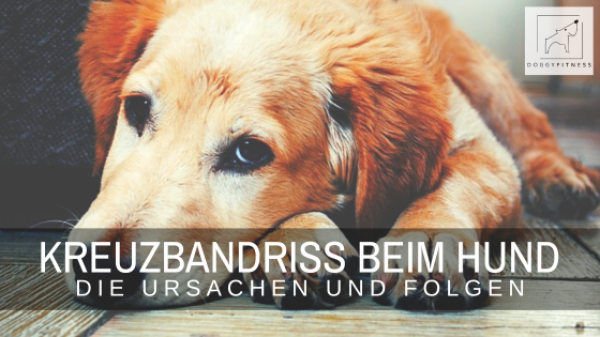The cruciate ligament rupture in dogs – feared by many dog people, because it occurs so unpredictably. Therefore, this blog article is mainly about the causes of cruciate ligament rupture and its consequences. Cruciate ligament rupture in dogs is a quite common joint disease and thanks to progressive diagnostics in the veterinary field it is diagnosed more and more frequently. In the case of a cruciate ligament tear, it is usually the anterior cruciate ligament that tears.
The trigger for the cruciate ligament rupture: in the rules a petty trauma such as a wrong movement, a stumble while playing with another dog or stepping into a hole in the ground.
But how can this happen? Cruciate ligament rupture in dog
Of course, a tape should not break just like that. Especially not for a movement that is quite commonplace after all. To understand what happens in the joint, let’s first take a look at the anatomy of the knee joint.
What is the structure of the dog’s knee joint?
The knee joint is the most complex joint of the dog. It is composed of the following bony components: Femur, tibia, fibula and kneecap. Thus, 4 bony elements are already involved in the formation of this one joint. These require a lot of support and stability, since a large part of the body weight rests on the knee and it is in motion a lot – namely with every step.
Different components thus provide stability and resilience on the one hand and the necessary flexibility on the other. These include muscles, the menisci, the joint capsule and the patellar ligament. There are 2 side straps that prevent lateral buckling.
Now the cruciate ligaments also come into play. There is an anterior and a posterior cruciate ligament. They give the knee joint stability to the front and to the back respectively. So much for the anatomy. For more detailed info on the knee joint, check out this blog post: the dog’s knee joint.
How does a cruciate ligament tear occur?
It is believed that there is a genetic predisposition that promotes premature and progressive wear of the cruciate ligaments. This continuously provides small tears in the cruciate ligament due to weak ligament tissue. Now the petty trauma comes into play again: at some point a few wrong movements are enough and the cruciate ligament is torn. Thus, the trauma, like a stumble in the game, is only the trigger.
Fatal is that in many dogs also at the second knee in the course of time the front cruciate ligament also tears. If the cruciate ligament is torn or ruptured, the knee joint becomes unstable. Osteoarthritis develops rapidly and the menisci are also damaged. Inflammation develops in the knee joint. The joint capsule swells. This is a reaction of the body, which is quite helpful. It restores stability to the knee joint.
But in addition to the cruciate ligament tear, the rest of the body is also affected. The lameness and sparing of the affected hind leg allows tension to develop in the overloaded areas such as the back muscles and shoulder muscles.
Which dogs are often affected by cruciate ligament rupture?
Medium to large dogs are often affected. As mentioned above in the article, a genetic predisposition favors premature wear of the cruciate ligaments. But also factors such as overloading and incorrect loading, as well as overweight, promote a cruciate ligament tear in dogs.
Extra tip for your dog with cruciate ligament tear
Your dog does not want to put weight on his hind leg after the cruciate ligament rupture? He is not alone in this. But there is a very helpful tip: put a scrunchie around his affected hind leg (above the paw). This makes him aware of his leg and thus supports him to use all four runs again.
All the love, your Tina
Dieser Beitrag ist auch verfügbar auf:
Français (French)
Deutsch (German)
Español (Spanish)
















